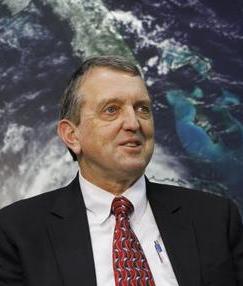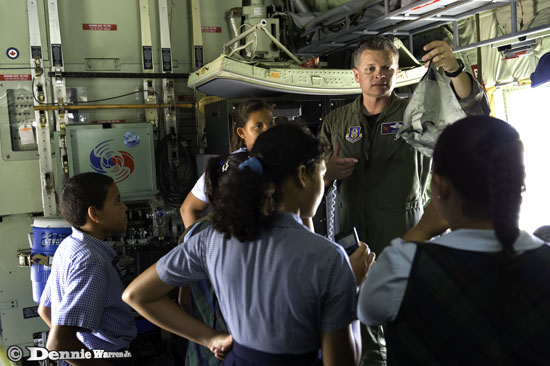Hurricane experts say science has saved lives
 (CNS): While the science of predicting hurricanes is still difficult, experts have revealed that the technological improvements in predictions and warnings in recent years have reduced the number of fatalities caused by hurricanes. Speaking at a special presentation, the first to be held in the brand new government building, visitors from NOAA’s hurricane centre in Miami revealed that their ability to predict the path of a hurricane was improving all the time, but when it come to intensity, hurricane forecaster Dr Lixion Avila said things had not really improved in the last two decades. NOAA’s director Bill Read (left) said the forecasters were hard on themselves and intensity prediction was not bad.
(CNS): While the science of predicting hurricanes is still difficult, experts have revealed that the technological improvements in predictions and warnings in recent years have reduced the number of fatalities caused by hurricanes. Speaking at a special presentation, the first to be held in the brand new government building, visitors from NOAA’s hurricane centre in Miami revealed that their ability to predict the path of a hurricane was improving all the time, but when it come to intensity, hurricane forecaster Dr Lixion Avila said things had not really improved in the last two decades. NOAA’s director Bill Read (left) said the forecasters were hard on themselves and intensity prediction was not bad.
The real challenge, he said, was predicting sudden increases in intensity far enough out to help people take action.
Read explained that forecasters can predict that a tropical storm will, over a given period and track, gradually reach a certain category of hurricane, enabling them to give warnings 48 hours out, but what science has not yet been able to do is to predict those very sudden increases in intensity. When the weather experts say that a tropical storm formed on Sunday and it will be a hurricane category one by Tuesday based on the conditions it’s travelling through, they cannot he admitted know that a sudden change inside the storm could in fact push it to a category three.
 Avila and Read were part of a team that were visiting Cayman on Wednesday as part of a regional tour to promote hurricane awareness. They arrived in Cayman on world meteorological day and during a regional tsunami drill, on board one of the 53rd Weather Reconnaissance Squadron, known as the Hurricane Hunters of the Air Force Reserve. These are the planes that fly into the eye of the storm and collect the data that Dr Avila and his colleagues use to help them predict hurricane paths and intensity. (Photo Dennie WArren Jr)
Avila and Read were part of a team that were visiting Cayman on Wednesday as part of a regional tour to promote hurricane awareness. They arrived in Cayman on world meteorological day and during a regional tsunami drill, on board one of the 53rd Weather Reconnaissance Squadron, known as the Hurricane Hunters of the Air Force Reserve. These are the planes that fly into the eye of the storm and collect the data that Dr Avila and his colleagues use to help them predict hurricane paths and intensity. (Photo Dennie WArren Jr)
The information from the hunters is among the most important, Avila explained, but information comes from various sources and is pulled together to create the forecasts, which are distributed across the region as a tropical storm forms moves towards the region and grows in size and intensity.
He explained that the science of tracking had improved enormously and that there were lots of good models that forecaster use to predict where the storm is likely to go. He said they were also hoping to improve it even more, helping to shrink the width of the areas that are placed on watches and warnings to reduce evacuations and the impact on communities.
However, Avila said it was the intensity models that still presented the problem for scientists. There are fewer of them and they are still not as accurate as they would like. “It has not improved much in twenty years but we are working hard,” Dr Avila said. “There are lots of very smart people who are gathering and examining data to give us a better computer model but we are not there yet.”
The weather experts have, however, improved their predictions over the years sufficiently well to save lives with the fatalities trend going down. (Read noted Katrina in 2005 was an exception but the death toll there was related directly to the failure of the levees.)
Read pointed out that the dollar losses continue to increase as houses built in hurricane zones get bigger and people acquire more stuff, meaning there is far more to lose when the major storms come through.
Another major challenge for the hurricane experts, Read said, is the awareness issue. Many people who live in the hurricane belt still don’t know their level of risk when it comes to flooding from storm surge or the category of hurricane which their homes are actually built to withstand.
Read said that throughout the US the building codes are often increased in the wake of a major hurricane but as the years pass buy the construction lobby manages to negotiate the standards back down again. He pointed out that a 2% increase on the cost of building the home can massively improve the ability of a house to withstand the most powerful of storms.
The visit of the hurricane experts and especially the hurricane hunter created considerable interest in the local community, as people queued up to tour the specialist aircraft at Owen Roberts InternationalAirport.
Cayman was one port of call on the tour, which each year stops off at a number of different places in the region that face the threat of hurricanes between June and November to promote awareness in the community and cooperation with local weather officials.
Category: Science and Nature


Why have we not learned our lesson from Ivan? Building code still allows new houses at just 5ft above sea level in Grand Cayman, when the major threat is flooding not wind. It would cost only a little more to consumers if we strengthen the code to 8ft or even 10ft (concrete stilts). But it would save $ millions and save lives when the inevitable flooding next comes.
No votes in it I guess